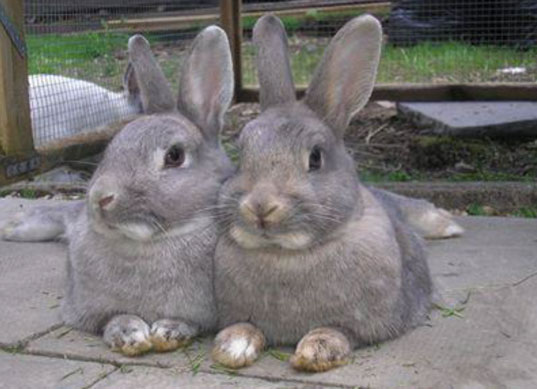Pet rabbit welfare guidance
This document provides detailed information about the needs of pet rabbits and how to meet these needs in accordance with good practice.
Section 1: Natural characteristics of rabbits
Domestic rabbits are descended from the wild European rabbit. Understanding the environment, diet and behaviour of this wild species helps us provide a suitable diet and environment for domestic rabbits, thus helping to ensure their good welfare. Human-habituated domestic rabbits are of course far more adaptable, and can become used to situations which may cause stress to wild rabbits, so it is not necessary to provide an environment which exactly replicates that experienced by their wild counterparts. Nevertheless, understanding the needs of wild rabbits is a very useful starting point.
Wild European rabbits generally live underground. They are crepuscular, so are most active above ground in the early morning and evening, around dawn and dusk. They will also come above ground at night, but will spend most of the daylight hours underground. Rabbits therefore spend much of their time in dark or low light conditions and do not like bright lights, although they will also graze and bask in the sun if they are in areas safe from predators.
Rabbits are prey animals whose predators include foxes, dogs, cats, birds of prey and stoats. This affects how and what they eat, how they communicate with each other and how they spend their time.
Rabbits eat grasses and other plants, and their teeth and digestive system are designed for poor quality, high fibre food. They slice the grass stems with their specially shaped, sharp, front teeth and grind them with their back teeth. Their teeth grow continuously throughout their lives. Rabbits spend about 70% of the time they are awake eating, although most of their food is eaten between 5pm and midnight.
Rabbits are social creatures, living in stable groups of between 2 and 10 individuals. A close bond forms between individuals within a group and this helps the rabbits feel safe and secure and gives them the best chance of survival, although during the breeding season rabbits can show aggression towards each other. Amongst the adults of a group there is a hierarchy, in which the dominant rabbits get first choice of food, burrow and who should groom them.
Rabbits show very subtle changes in behaviour to indicate when they are in pain or are frightened. Rabbits make a whole variety of sounds including grunts, growls, purrs and, if extremely frightened, they will scream. They also have a range of body, face and ear postures that can indicate rank, pleasure, pain, fear or aggression.
Scent is an important means of communication for rabbits. Rabbits rub their chin over objects and other rabbits, but this can also include those who handle them. Chin marking denotes territory and also acts as a means of identifying members of the rabbit's own group. It acts both to reassure rabbits that they are amongst friends, on home territory, and to deter intruders.
Rabbits also deposit scent with their faeces. Rabbits pass hard, small droppings as they move around, especially when feeding. Rabbits will scrape the ground near the boundaries of their territory and deposit a few droppings there as markers. Rabbits also deposit scent through spraying urine. Rabbits spray each other and, sometimes, people or other animals they live with.
Being a prey species, rabbits are very easily frightened and can remember what has frightened them. In the wild, rabbits can be attacked by birds of prey and by other animals on and under the ground. Thus rabbits are very alert to potential danger. Their first response is to freeze, but if the danger comes too close then they will run away to a safe hiding place. They will also thump the ground with their back legs to let other rabbits know of the potential danger. Only if there is no escape route do they tend to fight. Rabbits can be scared by many things, including sudden movements, loud and sudden noises, bright lights and strong smells.

Summary rabbit facts:
- Male rabbits are called bucks, females are called does and baby rabbits are called kits
- Rabbits are herbivores (plant eaters), eating mostly high fibre grass and other plants
- Rabbits have continuously growing teeth
- Rabbits produce soft droppings (caecotrophs) which they normally eat directly from their bottoms and then produce hard waste droppings
- Rabbits are crepuscular, preferring the low light conditions of dawn and dusk
- Rabbits are a prey species, and have many predators e.g. birds of prey, foxes, dogs and cats
- Rabbits are social, so need the company of other rabbits
- Rabbits are active, so need lots of space to perform all their natural behaviours
- Rabbits are curious, so need mental stimulation
- Rabbits are fearful, so need places to hide
- Rabbits in captivity have a life expectancy of 8 to 12 years (can be longer)
- Adult rabbits will weigh 1 to 10 kg (this varies with breed and sex)
- A rabbit's pregnancy lasts for 28 to 34 days
- The size of a rabbit's litter depends on the breed of the rabbit. Generally smaller dwarf breeds will have litters of 2-4, medium breeds will have litters of 4-6, and larger breeds will have litters of 6-10. An average litter is 5-8.
- Rabbits wean from their mother at 42 to 56 days old
- Rabbits reach puberty at 4-5 months in small breeds and 5-8 months in large breeds.
- Neutering age for rabbits is usually >3 months for males and >4 months for females. However early neutering at 8-10 weeks of age can be carried out where needed, for example in the case of mixed gender pairs where there is a risk of early puberty in small breeds.
Contact
There is a problem
Thanks for your feedback